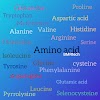Asparatic acid | History | Structure | Chemical properties | Function....
ASPARTIC ACID
Aspartic acid (symbol Asp or D) is an α-amino acid that is used in the biosynthesis of proteins.
Or
Aspartic Acid is a non-essential amino acid in humans, Aspartic Acid has an overall negative charge and plays an important role in the synthesis of other amino acids and in the citric acid and urea cycles.
Asparagine, arginine, lysine, methionine, isoleucine, and some nucleotides are synthesized from aspartic acid. Aspartic acid also serves as a neurotransmitter. Its α-amino group is in the protonated –NH+3 form under physiological conditions, while its α-carboxylic acid group is deprotonated −COO− under physiological conditions. Aspartic acid has an acidic side chain (CH2COOH) which reacts with other amino acids, enzymes and proteins in the body. It is a non-essential amino acid in humans, meaning the body can synthesize it as needed. It is encoded by the codons GAU and GAC. D-Aspartate is one of two D-amino acids commonly found in mammals. In proteins aspartate sidechains are often hydrogen bonded to form asx turns or asx motifs, which frequently occur at the N-termini of alpha helices. The L-isomer of Asp is one of the 22 proteinogenic amino acids, i.e., the building blocks of proteins.
Properties :-
Chemical formula :- C4H7NO4
Molar mass :- 133.103 g·mol−1
Appearance :- colourless crystals
Density :- 1.7 g/cm3
Melting point :- 270 °C (518 °F; 543 K)
Boiling point :- 324 °C (615 °F; 597 K) (decomposes)
Thermodynamic data :- Phase behaviour (solid–liquid–gas)
STRUCTURE :-
HISTORY :-
Aspartic acid was first discovered in 1827 by Auguste-Arthur Plisson and Étienne Ossian Henry by hydrolysis of asparagine, which had been isolated from asparagus juice in 1806. Their original method used lead hydroxide, but various other acids or bases are now more commonly used instead.
SYNTHESIS :-
Biosynthesis :- In the human body, aspartate is most frequently synthesized through the transamination of oxaloacetate. The biosynthesis of aspartate is facilitated by an aminotransferase enzyme: the transfer of an amine group from another molecule such as alanine or glutamine yields aspartate and an alpha-keto acid. Aspartate also plays an important role in the urea cycle.
Chemical synthesis :- Industrially, aspartate is produced by amination of fumarate catalyzed by L-aspartate ammonia-lyase. Racemic aspartic acid can be synthesized from diethyl sodium phthalimidomalonate, (C6H4(CO)2NC(CO2Et)2).
Sources :-
Dietary source :- Aspartic acid is not an essential amino acid, which means that it can be synthesized from central metabolic pathway intermediates in humans. However, aspartic acid is found in:
Animal sources: oysters, luncheon meats, sausage meat, wild game. Vegetable sources: sprouting seeds, oat flakes, avocado, asparagus, young sugarcane, and molasses from sugar beets. Dietary supplements, either as aspartic acid itself or salts (such as magnesium aspartate). The sweetener aspartame, an aspartic acid, phenylalanine, formaldehyde trimer (brands: NutraSweet, Equal, Canderel, etc.)







0 Comments